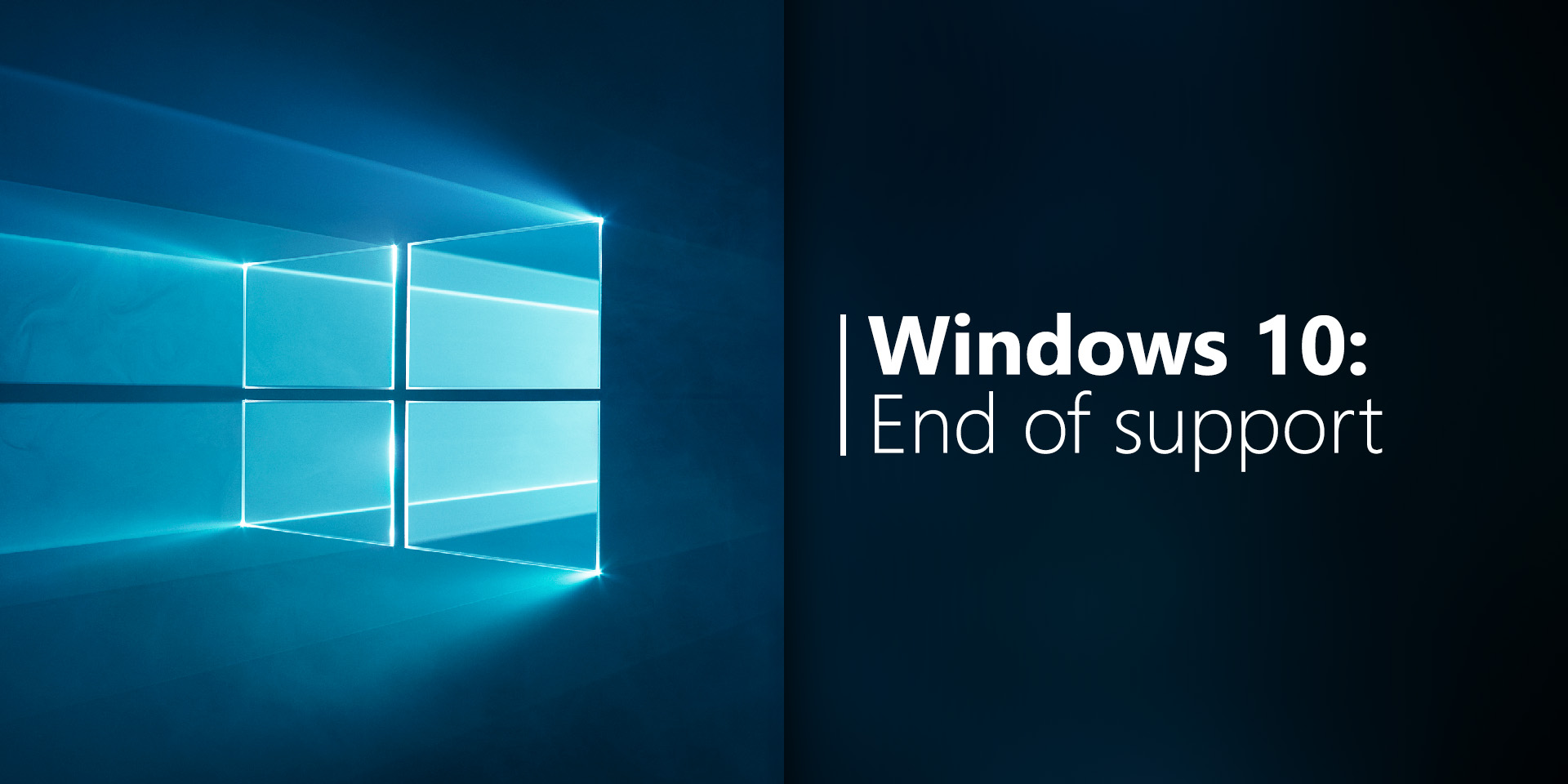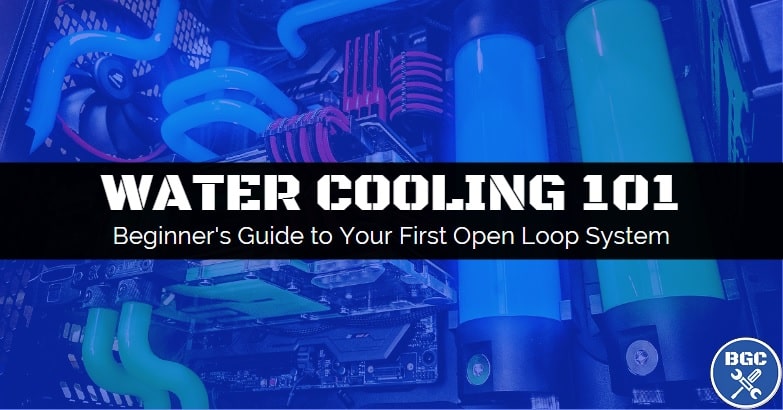
Residence > Gaming PC Builds > Water Cooling
Water Cooling 101, Open vs Closed Loops, Loop Design, Choosing Components, & Set up
Final Up to date: Could 18, 2021
Ever questioned how you can plan and set up a customized water cooling loop into your gaming PC? At this time’s your fortunate day; on this complete introduction to the fantastic world of water cooling PC builds we’ll dive into all the pieces you’ll want to know as a newbie in a simple to grasp method so no noob will get left stranded at sea. Tremendous dangerous puns apart (for only a second; brace yourselves), studying how you can construct a water cooled PC is much from obligatory for the far majority PC builders, however there’s simply no escaping the truth that there’s actually nothing cooler in terms of a DIY PC.
As much as the slight problem? Have ranges of endurance rivaling Grasp Windu or his little inexperienced good friend? NOT a complete beginner assembling your very first pc? This complete information to constructing a water cooling PC is your roadmap to getting your ft moist on this almost-always overkill but awesomely-alluring characteristic, and can clarify all the fundamental fundamentals to get your liquid quest off on the appropriate foot.
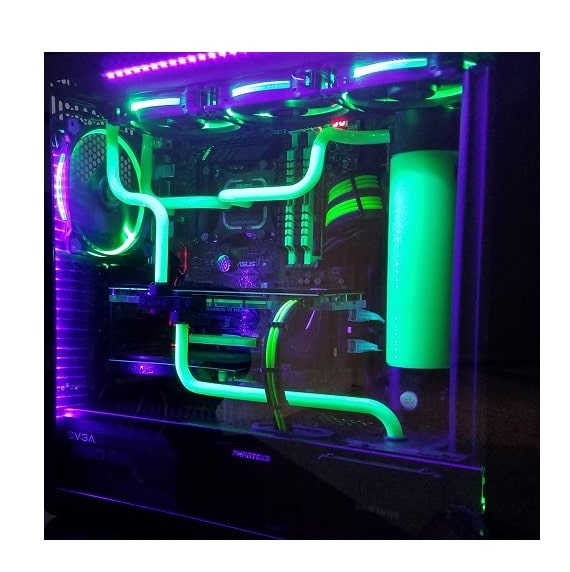 That is the best way (Supply: Imgur)
That is the best way (Supply: Imgur)Some folks make constructing a water cooling PC look like this extraordinarily elusive, near-impossible process reserved just for savvy pc engineers, Tech Jesus AKA Steve from Gamer’s Nexus, and Elon Musk. Sure, it takes time and endurance to discover ways to set up water cooling elements, keep your loop, and select the appropriate mixture of water cooling components within the first place. Nevertheless it is not rocket science. Similar to constructing any excessive efficiency PC, it is about taking one step at a time and following directions. Although as talked about, for those who’re constructing a PC for the very first time and maybe simply realized what an SSD is that this previous week, for the love of Half Life do give customized loops a miss (for now).
So, whether or not you are a low-spec gamer simply right here to return alongside for a tire-kicking experience down the rabbit gap of water cooling, nonetheless weighing up the professionals and cons to putting in an open loop in your PC, or have already determined to make the leap into your first customized water mission (both for sensible functions or simply for the enjoyable flex of it) – you’ll discover as you go additional alongside on this PC water cooling information that it is actually doable for anybody who’s constructed a high-end PC earlier than, and nothing to be intimidated by for those who merely allocate the required time (days, not hours).
Water Cooling Introduction
What’s Water Cooling?
Laptop {hardware} can generate a ton of warmth, particularly when below heavy load akin to demanding purposes/video games, and/or once you overclock your elements to push them to their limits. The usual method computer systems settle down your {hardware} elements to maintain them working at a protected temperature is by transferring air, akin to with a typical heat-sink-and-fan mixture in your CPU (ie CPU cooler).
However in comparison with air, water is on one other stage of effectiveness as a result of it has excessive thermal conductivity, that means it could possibly soak up warmth extra simply. With a full water cooling PC construct (there’s such a factor as {a partially} water cooled construct, ie AiO liquid coolers; extra on that under), as a substitute of air blowing in your elements, water is run over them to very successfully switch the warmth these elements generate to a radiator that then dissipates that warmth. A water cooled PC not solely reduces warmth extra successfully than air, and reduces or straight-up eliminates noise (followers will be loud once they must work exhausting), however it could possibly additionally improve the utmost efficiency you possibly can squeeze out of your components when overclocking.
With a well-designed water cooled rig, fans trying to overclock their elements to the restrict can have the security web to push their components additional and sooner than what air cooling would usually enable. While customized loops are normally solely tackled by power-hungry customers with massive budgets who’re constructing a monster system or {hardware} fans who carry out extremely demanding duties with their computer systems akin to intense overclocking, utilizing water-cooling in your PC doesn’t must imply you go all-out and design and implement a customized loop.
You could possibly merely go the a lot less complicated, frequent method of utilizing a pre-built, closed-loop CPU liquid cooler (additionally referred to as AiO liquid coolers; “All in One”) which we can even speak about on this information. However total, nothing beats a full customized loop for optimum cooling capability, effectiveness and noise elimination. Oh, and aesthetics; a customized loop provides a very distinctive contact to any construct.
Air Cooling vs Water Cooling
To match air cooling and liquid cooling your PC {hardware} elements, we’ll use the CPU for example which is probably the most generally water-cooled piece of {hardware}. Bear in mind although that with customized water cooling setups you possibly can water-cool just about any part that your coronary heart needs. With a regular, air-cooled CPU, the warmth generated by the processor is transferred into the warmth sink. The fan sucks air previous the warmth sink, drawing warmth away from the warmth sink because it does so. The recent air is then pushed out of your case via the rear by your case followers.
As for a water-cooled CPU, as a substitute of air getting used to switch the warmth generated by the CPU, water is used. The coolant is pumped via a tube and the warmth is transferred via an inlet into what’s referred to as a cooling block, which is mainly a hole warmth sink, after which the heated coolant is pumped right into a reservoir after which right into a radiator which is then cooled by a fan. The coolant than continues its merry journey to the cooling block and the fantastic cycle continues. As talked about, water cooling is more practical and quieter than commonplace air cooling, however air cooling remains to be the commonest technique utilized in computer systems at the moment. As time goes on who is aware of whether or not that may change as water cooling turns into extra simply accessible to on a regular basis customers, however in the intervening time water cooling will stay a luxurious.
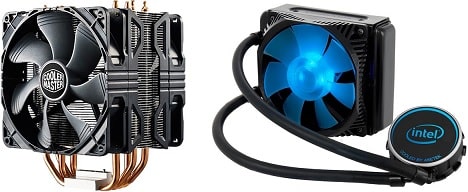 Air? Good to Nice. Liquid? Nice to Legendary.
Air? Good to Nice. Liquid? Nice to Legendary.Open vs Closed Loop Water Cooling
What’s an open loop water cooled PC? What about closed loops? These are the 2 important sorts of water cooling you possibly can embrace in your construct, and on this water cooling information we’re overlaying how you can construct a full open-loop system. An open loop water cooling system is one which travels round your PC in, properly, a loop. A closed loop system is proscribed to only one part – normally the CPU.
These are known as AiO (All in On) liquid coolers, and it is the straightforward strategy to get into water cooling for the primary time. They are much less complicated to put in and keep than a full open loop setup, and can successfully preserve a CPU cool and quiet. Examples of AiO/closed-loop programs embrace Corsair’s widespread Hydro Collection and the NZXT Kraken vary – each frequent inclusions in our finest gaming PC builds of the month so see our newest construct suggestions for particular suggestions for sure CPUs.
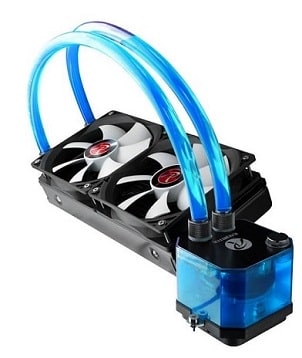 A closed loop water cooling system, technically referred to as an AiO
A closed loop water cooling system, technically referred to as an AiOEfficiency of AiO liquid coolers vs air coolers can really be very shut although, and a few high-end air coolers from main corporations like Noctua can maintain their very own in opposition to the perfect AiO liquid coolers on the market.
Typically talking, a superb AiO cooler will beat most air CPU coolers total in each temps and noise, however the reality is, getting a prime air cooler in your CPU can present the identical stage of efficiency as a liquid AiO, and typically for rather less price if which fashions to select (for instance, the Darkish Rock Professional 4 is a beast and goes toe to toe even with higher-priced AiO coolers).
So, there’s normally no sensible must get a AiO liquid CPU cooler over a superb CPU cooler until you are on the intense finish of the spectrum and doing heavy overclocking on an extreme-tier CPU (the place a high-end $150+ liquid cooler will be justified when it comes to precise practicality).
Nonetheless, liquid coolers certain do look rather a lot cooler in a completed system, and so whereas there’s typically no need for them over a top quality air resolution in most builds, AiO liquid coolers are a preferred decisions in high-end programs for that reason. Air coolers alternatively can look fairly unappealing, although it will depend on the mannequin and a few can look nice, too (however have you ever seen these beige Noctua’s? Wonderful efficiency, however removed from fairly).
However to extract most advantages from a water cooling PC construct, the subsequent stage is to construct your personal customized loop (open loop, that’s) which is the place the actual enjoyable begins and can’t be matched when it comes to temperatures, noise discount and naturally aesthetics. Once you construct a customized water cooling loop you’ve gotten the liberty to chill all or any elements in your rig, whether or not that’s your CPU, your graphics card/s, and different elements akin to your RAM, motherboard, and even storage gadgets are honest sport. However there are professionals and cons to constructing an open loop, and it is not for everybody.
Downsides to Water Cooling
First let’s have a look at the potential dangerous information; whereas water cooling feels like the good factor ever, there are some potential drawbacks to think about. Though it’s honest to say these cons aren’t actually a difficulty for affected person fans with a wholesome funds who additionally discover this kinda stuff enjoyable, nevertheless it’s value discussing each side of the coin.
To start with, moreover AiO liquid coolers I simply talked about above (closed-loop water cooling), a customized open-loop system is extra sophisticated to plan, setup and keep. There’s fairly just a few extra components that go into it together with water blocks, radiators, pumps, reservoirs, tubing, fittings, and so forth, and so a good bit extra little nuances and particulars to consider. That naturally additionally means there’s extra that would probably go flawed (learn: that you just or I’d simply screw up).
Upkeep is not THAT concerned to be trustworthy as you will see later on this water cooling information, as coolants most likely solely have to be changed about as soon as each 6 months to a 12 months or so in a typical loop, nevertheless it’s undoubtedly extra upkeep than a regular water-free rig.
As for worst-case situations like water leaks which might harm your total system, it is a very uncommon factor for those who set issues up correctly (set up your PSU consumption fan going through downwards to keep away from leaks getting in) however it could possibly occur so there’s that danger to have in mind. Value can be one other draw back as water cooling components can add up in price fairly quick, particularly for those who purchase premium like good previous EKWB (extremely advisable). Even a reasonably primary customized loop will set you again no less than just a few hundred {dollars} on prime of the price of your core system.
Advantages to Water Cooling
As for the benefits, properly for one it is fairly freakin’ superior and I am unable to think about something extra satisfying throughout the {hardware} neighborhood than having efficiently constructed your personal customized water-cooled machine. You will be in a rarer, elite class of PC builders that had the braveness and the know-how (and let’s face it, the pockets) to make all of it occur.
And moreover the advantages we have already talked about akin to water cooling being the simplest cooling technique in your {hardware} on the lowest ranges of noise (or ought to I say whisper silent), it additionally seems significantly cool in motion. For a lot of fans who enterprise into water cooling territory, the distinctive aesthetic potentialities of a water-cooled PC is an enormous drawcard. A properly kitted-out air-cooled PC can look fairly rattling superior with the appropriate mixture of components and equipment, however water cooling is the head. Nothing seems, properly, cooler! Not even a twin GPU SLI gaming PC seems sweeter in motion.
On prime of getting the simplest cooling, lowest noise, and finest seems, putting in a customized water cooling loop in your PC can even lengthen the lifetime of your elements as they’ll be working at peak effectivity because of the decrease warmth. Lastly, with a properly water-cooled PC you’ve gotten the power and security web to overclock your gaming PC additional than you safely might in any other case. Subsequently, with a full open loop water cooling system in your PC you are opening up the floodgates to unlocking the utmost potential of your high-performance system.
Selecting the Greatest Components for Water Cooling
Now we get to the great things and the center of PC water cooling; customized water loops. They’re fairly concerned, as you will see by all the assorted items of the puzzle that we’ll clarify right here, and we do not advocate creating one until you’ve gotten the curiosity, time, cash and endurance to do your personal thorough analysis to design and set up the appropriate setup for you, and to do it proper.
Bear in mind there are all-in-one kits that may prevent money and time as properly, however right here we’ll clarify how you can setup a completely personalized loop by sourcing every half individually which supplies you probably the most management. As we undergo every particular person part of a customized water system and what to look out for when deciding on the appropriate one in your setup, take into accout that is simply an outline and you need to do your personal further analysis to have in mind your particular goals and wishes.
Every loop is a bit distinctive and we received’t be recommending particular components right here, however researching and designing your personal customized loop is a part of the enjoyable. This introductory information is supposed to set you off on the appropriate foot, however don’t let your studying cease with this information as water cooling has many little nuances and technicalities and is the kind of factor that must be completely researched in your personal state of affairs in case you are to tug it off successfully.
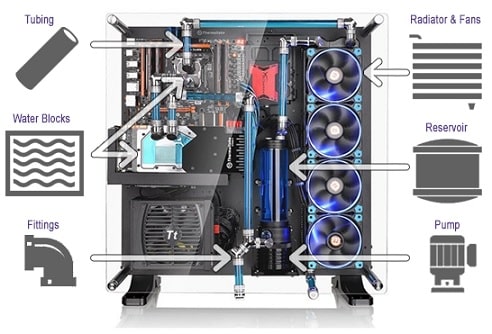
Components Wanted for Open Loop Water Cooling
These are the elements required to construct a full water cooled PC:
- Water Block/s
- Radiator/s (with followers)
- Pump
- Reservoir or pump/reservoir combo (elective however advisable)
- Tubing (comfortable or exhausting)
- Fittings (2 per merchandise)
- Coolant (distilled water + components or kill coil, or particular coolant)
For the remainder of this part we’ll cowl tips about selecting every part, but in addition try these helpful configuration instruments which can make it easier to plan a suitable water loop:
Aluminium vs Copper Water Cooling Components
The most cost effective water cooling components you discover could also be fabricated from aluminium, which is okay if on a funds however is not supreme. Moreover being low cost, aluminium water cooling components do have the benefit of being light-weight, however they supply much less efficiency in comparison with different metals like copper or brass. Plus, you need to keep away from mixing aluminum components with different metals, as when doing so a phenomenon often known as galvanic corrosion can happen and harm your components (and even create leaks). See this for extra on corrosion.
Because of this, aluminium water cooling components are much less versatile when it comes to future upgrades too, as for those who begin your construct with aluminium you then’re kinda restricted within the upgrades you may make later down the highway if you wish to keep away from points. However once more, for a funds water cooling PC construct, aluminium is not the top of the world IF you keep in mind to keep away from mixing it with different metals inside your loop.
Planning Your Loop Complexity
You can also make your open water cooling loop as easy or advanced as you want, and the probabilities today are limitless and you’ll water-cool absolutely anything in your PC. Your most elementary choice is to arrange a single loop that simply cools your CPU. This is step one up from utilizing a pre-built/closed-loop liquid cooler (AiO), however remains to be comparatively easy to undertake as a newbie.
This primary stage of a customized water cooling PC will nonetheless embrace the entire core components that make up extra advanced loops; you’ll want a water block in your CPU, radiator, reservoir, pump, tubing and fittings. For those who’re model new to the water-world and never eager to delve in too deep, this can be a good place to start out as you’re limiting potential issues and also you’ll acquire some confidence within the course of. It’s additionally going to avoid wasting you cash as you received’t must shell out a ton of money for extra components, and you’ll at all times add to your loop later.
The subsequent step up in complexity for a customized loop PC construct can be to throw your graphics card into the combo. For this you’ll want an acceptable GPU water block, and probably a bigger radiator than the one that might have been used for a CPU-only loop. Or, you possibly can add a second radiator as a substitute to extend the general cooling capability of the loop.
Past that you’ve got the choice to chill different elements akin to your RAM modules and motherboard, which can all want their very own water blocks. Going even additional and also you get into dual-loop territory for superior fans, however that is getting into ridiculous territory and past the scope of this already way-too-long water cooling information.
All-in-One Water Cooling Kits
To not be confused with All-in-One CPU liquid coolers, you may also discover all-in-one full water cooling kits that normally comprise all the pieces you want for a primary water cooling PC construct. These are undoubtedly value contemplating for those who’re making an attempt to maintain issues easy as they will assist take compatibility points out of the equation. They might additionally prevent some coin. I am not right here to advocate particular fashions as what you can purchase will depend on numerous components akin to your explicit PC specs, funds, stage of curiosity, and so forth, however for examples of what is on the market, these two water cooling kits from Thermaltake and EKWB are widespread for learners:
Thermaltake Pacific C360 DDC Tender Tube Water Cooling Equipment
EKWB EK-KIT Efficiency Collection PC Watercooling Equipment P360
The right way to Select Water Cooling Blocks
A water block is what you mount onto every {hardware} part that you just want to embrace in your loop, and is used to switch warmth vitality from that part and into the water in your loop. Water blocks depend on floor space to trade warmth successfully, with extra floor space equalling extra warmth being transferred and subsequently more practical cooling.
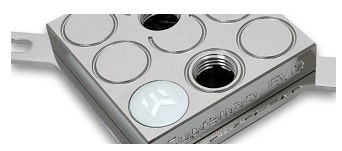 What a CPU water block seems like
What a CPU water block seems likeA water block is what you mount onto every part you need included within the loop, and is used to switch warmth from the part and into the liquid throughout the loop. Water blocks depend on floor space to trade warmth successfully, with extra floor space equalling extra warmth being transferred, and subsequently more practical cooling. Water blocks use both pins, fins and/or channels to extend floor space, with CPU water blocks usually utilizing pins and fins.
GPU water blocks are available in two varieties; full cowl and common blocks. Full cowl blocks will match the one particular GPU mannequin whereas common blocks will, you guessed it, match a spread a unique graphics playing cards. Motherboard water blocks are like GPU ones; they’ve common and model-specific variations. RAM, storage drive, and even PSU water blocks are on the market, however hardly ever value it, and solely probably the most hardcore fanatic would think about getting blocks for these elements. Together with these elements in a water cooling loop can be extra for seems than practicality.
So, you’ll want an acceptable water block for each part you wish to embrace in your loop. For those who can’t discover blocks that suit your explicit components for no matter purpose, then I’m sorry to be a dream-killer however your water-cooling aspirations will not be potential. However don’t fear; commonest, fashionable components can have appropriate blocks on the market someplace.
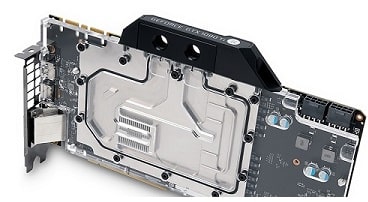 What a GPU water block seems like
What a GPU water block seems likeListed below are some issues to bear in mind when selecting the best water blocks in your PC:
- Ideally search for a water block with a high-flow design and low hydraulic restriction.
- Water blocks for CPUs are likely to help both Intel or AMD CPUs, however some will help both. Both method don’t overlook to verify it helps your CPU’s socket sort, and ideally your particular CPU mannequin too (however socket sort ought to be all you want).
- Search round on-line for opinions and further recommendation earlier than shopping for a water block to foresee any potential issues you may need with it.
- Be sure that the water block/s you purchase comes with all of the items you’ll want to set up it, akin to a backplate, mounting mechanism and mounting screws and so on, in any other case you’ll must supply these your self.
- You’ll additionally want thermal paste similar to when putting in an aftermarket CPU cooler; some blocks will include some, some received’t, and a few blocks may need it pre-applied. Sure, you’ll want thermal paste for a GPU water block too, and never only for CPUs.
- For cooling a GPU, a full cowl block (versus a common block) is the simplest, best-looking, but most-expensive choice. It could or could not cowl your total card, however both method it’ll cowl all of the necessary bits of the cardboard that must be cooled. Full cowl GPU blocks will solely help the one particular GPU mannequin.
- To scale back corrosion you need to follow blocks fabricated from the identical metallic; in case you have a copper CPU block then attempt to additionally get a GPU block fabricated from copper.
The right way to Select Water Cooling Radiators & Followers
Radiators operate to maintain the water cool because it strikes across the loop. It does this by exchanging warmth with the encircling air through the copper fins that make up the radiator’s core. Heated water flows via these fins and are cooled by the radiator’s fan.
They arrive in numerous shapes, sizes, thicknesses and fin densities. Generally, the larger the general floor space of your radiator, whether or not that’s one huge radiator or a number of smaller ones, the more practical your loop shall be dissipating warmth, which additionally results in much less noise as followers will be run at slower speeds (the sooner followers rotate, the nosier they are often).
It’s important to select a radiator (or a number of radiators) that’s going to comfortably slot in your case. rule of thumb to comply with is to shoot for at least 120mm/140mm of radiator floor space for every part you might be cooling within the loop, and so as to add one other 120/140mm if that half shall be overclocked.
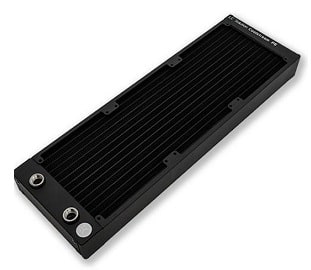 What a water cooling radiator seems like
What a water cooling radiator seems likeFor instance, for those who’re designing a customized loop with solely an overclocked CPU to be included within the loop, you’ll want 240mm of radiator house, whether or not that’s 2 x 120mm radiators or 1 x 120mm radiator.
The thickness and fin density of your radiator, measured in FPI (fins per inch), are additionally pretty necessary concerns and can dictate what sort of fan you wish to use in your radiator. Thickness is measured in mm and might vary quite a bit from say 20mm to all the best way as much as round 80mm.
The upper the FPI of a radiator, the upper the static strain you will require to successfully flow into cool air via that radiator. An FPI of 30 and above is on the excessive finish, whereas 10 and below is taken into account low.
A radiator with a excessive FPI of over 30 ought to ideally be paired up with static strain optimized followers, whereas decrease FPI radiators of say below 15-20 could not see a lot of a distinction with static strain followers (over airflow followers).
Radiators additionally produce other options akin to Crossflow, the place there’s an inlet on both facet of the radiator, versus the usual inlets on the one facet, which can assist some water loop setups. Some radiators even have numerous fin supplies which may enhance efficiency. Then there’s shrouds which are sometimes fabricated from plastic and used to separate the fan and radiator by roughly an inch or so to lower the scale of what is referred to as the “useless zone” – the place of no air {that a} radiator-mounted fan has. Fans additionally use them solely for aesthetic functions as properly.
Video Information: The right way to Choose the Proper Measurement Radiator (EKWB)
The right way to Select a Water Cooling Pump
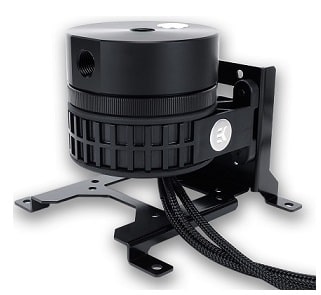 What a water cooling pump seems like
What a water cooling pump seems likeFor a customized water cooling setup you will want a pump to flow into the coolant round your joyous merry-go-round loop of glory. Pumps are the center of a water cooling configuration and are available in all method of various designs and sizes with various energy necessities and noise output. It is a primary but essential part that units the entire thing in movement, and the extra elements you want to water-cool, the stronger your pump must be.
The stream fee of the pump measures how a lot water your pump can flow into with out restriction, and is a reasonably necessary consideration to account for. Nonetheless, the utmost stream fee of a pump that producers point out on their merchandise assumes a zero static head strain, that means the precise stream fee can be fairly a bit decrease than the utmost listed stream fee.
The commonest sort of water pump today known as a DC pump, which is probably the most cost-effective and is usually extremely dependable with solely the only transferring half, though there are extra highly effective pumps on the market for extra concerned, high-end customized loops. The factor is although, if you would like improve cooling efficiency, it’s possible you’ll be higher off getting a much bigger radiator as a substitute of a stronger pump. As at all times, do not take our phrase for it and do your analysis.
The right way to Select a Water Cooling Reservoir
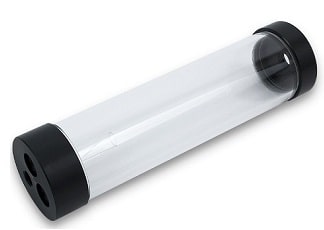 What a water cooling reservoir seems like
What a water cooling reservoir seems likeIn a water cooling loop a reservoir is used to carry the coolant within the loop, making bleeding out bubbles straightforward. In different phrases, it permits air bubbles to slowly get replaced by water because it circulates. It is also the filling level for the coolant. Reservoirs are available in stand-alone type or as a pump and reservoir mixture. Most are designed to be mounted inside your case, whereas others are mounted inside a 5.25 inch exterior drive bay.
Some reservoirs additionally include pump mounts and different helpful options which will come in useful in your explicit setup. A reservoir shouldn’t be technically required for a whole, working water cooling loop however having one is unquestionably advocate as they can assist scale back temperatures and so they make filling and bleeding the air out of your loop fairly a bit simpler.
Selecting Water Cooling Tubing, Springs & Coils
The operate of the tubing a part of a water cooling setup is fairly self-explanatory, and is what permits the coolant to stream round via all of the components of the system, nevertheless it does are available in many differing types, supplies and sizes and so there are plenty of choices to think about. The very first thing to think about is whether or not you wish to get comfortable or exhausting tubing. Tender tubing is extra versatile, simpler to bend, cheaper and simpler to work with so is recommended for learners.
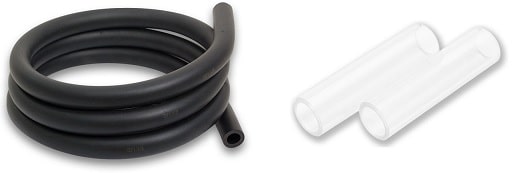 You have to select between comfortable or exhausting tubing in your loop
You have to select between comfortable or exhausting tubing in your loopArduous tubing requires extra work and can have to be heated and bent into form to achieve your fittings, and is just advisable for extra skilled {hardware} fans or learners prepared to place within the time. In relation to dimension, tubing is measured in 3 ways:
- ID – Quick for Interior Diameter, that is the diameter of the internal wall of the tubing and is often 1/2 inch, 3/8 inch or 7/16 inch.
- OD – Quick for Outer Diameter, that is the measurement of the outer wall of tubing with frequent sizes being 1/2 inch, 5/8 inch or 3/4 inch.
- Wall Thickness – The distinction between the OD and the ID (in different phrases; OD minus ID).
The tubing you get shall be primarily based on each the house you’ve gotten inside your rig in addition to private desire. Oh, and your funds too, as tubing can actually add up for those who go for premium-quality. You’ll wish to ensure the tubing you get will work with the fittings you get, and that the ID and OD of your tubing is suitable with the ID and OD of your fittings (we are going to speak a bit about fittings in a bit).
This mainly signifies that they need to be the identical measurements, nevertheless you possibly can usually use tubing that’s smaller than your fittings for a good match. For those who’re going to be utilizing 1/2 inch tubing or bigger, you’ll most likely must get clamps to carry them in place. Tubing additionally is available in numerous materials varieties:
- Vinyl – The most cost effective choice and advisable to keep away from for those who can as it could possibly fairly simply create kinks.
- Clearflex – Higher than vinyl and a pleasant middle-ground choice.
- Tygon – The costliest but highest-quality, most versatile choice for tubing.
What you may also do together with your tubing, for those who go for probably the most economical supplies, is add springs or coils fabricated from plastic to the within and outdoors of the tubing to maintain it spherical. Springs that go on the within of the tubing (but hardly hamper water stream) should match the ID of your tubing. The coils will go on the surface (and are typically used for aesthetic causes as properly) and might want to match the OD of your tubing.
As for the size of tubing to get, that may rely in your explicit setup, however normally it’s possible you’ll want round 5-10 ft of tubing for a typical loop. Ideally, you’ll wish to get a bit further size than you assume you’ll want to have some obtainable headroom, and it’s possible you’ll wish to get an additional couple of fittings than you assume you’ll want too. It will be annoying going to place your system collectively solely to seek out you’re lacking a little bit of tubing or a becoming and having to re-order and play the ready sport.
Selecting the Proper Water Cooling Fittings
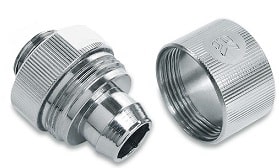 What water cooling fittings seem like
What water cooling fittings seem likeThe fittings are what will let you join your tubing with the opposite components in your loop, and so they are available in numerous sizes and styles. Their fashion can even rely on whether or not you’re utilizing comfortable or exhausting tubing, and normally you’ll be needing two fittings for each a part of your loop (ie your water blocks, radiators, reservoir and so on).
In relation to selecting fittings you’ve gotten the choice of both barb fittings, that are mainly only a spout that matches onto your loop components and are the economical choice, or compression fittings that are like barbs however with a compression ring on the surface for further safety and a tighter match.
Compression fittings are costlier however look higher, and so they are available in both a standard or acrylic fashion, with acrylic fittings designed for use round exhausting tubing. You may also get angled fittings which may enhance the aesthetics of your loop. When searching for barbs you’ll want to verify the ID of your tubing matches the barb dimension. As for getting compression fittings, you’ll must verify that each the ID and OD of your tubing shall be suitable.
Selecting Water Cooling Coolant & Components
 Coolant is available in all types of colours
Coolant is available in all types of coloursNow to the precise liquid that shall be gloriously flowing round your loop, coolant is made up of distilled water and components that kill dwelling organisms and stop corrosion, and you’ll both purchase particular water cooling coolant or you should buy the components individually and make up your personal.
For those who go the do-it-yourself route then ensure to make use of distilled water, as faucet water can comprise impurities which will trigger algae to develop in your system, which might then result in clogged up tubing and corrode the water blocks. Reminder to self: avoiding ingesting unfiltered faucet water every time potential!
As for the components so as to add to your distilled water, a few widespread choices are Biocide and Silver Kill Coils. With Biocide you add just a few drops within the water and it’ll stop something from rising, with PT Nuke being a superb, widespread model.
Then again, a Silver Kill Coil is a small piece of silver that you just place inside your loop the place the water flows that can even stop life progress (as a result of silver is a pure biocide).
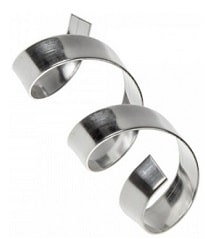 What a kill coil seems like
What a kill coil seems likeIn addition to both Biocide or a Silver Kill Coil, in case your customized loop comprises a couple of sort of metallic you then’ll wish to add an anti-corrosive product to your coolant to, you guessed it, cease corrosion. For instance, for those who’re utilizing a copper block together with an aluminium radiator, you’ll wish to add an anti-corrosive. model for that is Fesser Base.
Whereas not obligatory, some folks additionally like so as to add a touch of dishwashing liquid which can assist eliminate bubbles and acts as a surfactant (which is, to keep away from getting too technical, one thing that lowers the floor stress).
As for including coloring to your coolant; it’s a blended bag as it could possibly very properly trigger your system to gum up. If you need a coloured water loop, probably the most dependable choice is to get coloured tubing which nonetheless seems superior. For those who do get coloured coolant, do your analysis as to what others have been experiencing with that specific product.
Selecting the Greatest Case for Water Cooling
Don’t overlook that your collection of pc case is a crucial a part of constructing a customized water cooled gaming PC, as you’ll want to seek out one that may accommodate all of the components of your customized loop, and that doesn’t make constructing your loop too troublesome because it’s advanced sufficient as it’s.
Your chassis will want the additional room for the radiators; with a regular air cooled system your case solely wants fan mounts and 25mm of house as most case followers are that thick. However water cooling radiators begin at 25mm thickness and might go all the best way as much as 80mm, so you’ll want to take that under consideration plus the additional house for the followers as properly. You additionally want extra room for the reservoir, pump and tubing.
When selecting a case for a water cooled gaming PC construct it’s not simply the scale of the chassis that’s necessary however the inside format. Actually, it’s potential to make use of a smaller case for a customized water cooling loop if it’s designed properly, though generally it would be best to get a mid tower on the very least with a full-tower being supreme for probably the most flexibility.

You need a case that’s really designed with water cooling in thoughts, and sticking to manufacturers like Phanteks, Fractal Design, Corsair, In Win, Caselabs, and NZXT who’re recognized to supply nice water cooling pleasant circumstances is a good suggestion. Different manufacturers may have appropriate circumstances, however the manufacturers simply talked about are among the many better of the perfect in terms of water cooling setups.
You’ll must do your personal thorough analysis on the precise case you select to make doubly certain that it’s going to fit your actual customized loop with out points. The circumstances we embrace within the higher-end builds of our month-to-month finest gaming PC builds part (ie the builds $1500 and over) are virtually at all times water-cooling pleasant, so these could also be strong decisions for putting in a loop. Take a look at the finished water cooling PC builds at PCPartPicker for concepts too, and take a look at this nice information by EK for extra tips about selecting a case.
The place to Purchase Water Cooling Components (Shops)
Under we’ve listed a number of the present hottest shops throughout North America, Canada, UK, and Australia the place you should buy a superb vary of water cooling elements (moreover Amazon, which kinda goes with out saying today as most individuals know to verify Amazon costs first as they’re at all times aggressive). Apologies in case your nation shouldn’t be included under because the under nations are those I do know properly when it comes to the {hardware} market; I am much less savvy concerning the {hardware} market in different nations.
The right way to Set up a Water Cooling Loop
Accompanying pictures for the under steps on putting in your customized loop coming quickly as soon as my subsequent PC construct is full (which can hopefully have a loop!). You possibly can keep notified as quickly because the up to date version of this information with the brand new pictures releases by subscribing to our e-mail publication on the backside of the web page. For now, under are the overall steps and precautions to put in all of the components to a customized loop as soon as you have completed putting in all of your important PC {hardware} elements (assuming you are constructing a complete water cooled PC from scratch). However see the linked video later on this information for additional assist too (below our 2020 advisable RTX 2080 Ti water cooled construct).
Instruments Wanted to Set up a Water Cooling Loop
After you have all of the components you want in your loop and also you’re beaming with pleasure to lastly put this factor collectively and declare your rightful place alongside the {hardware} elite, there are a pair issues to learn about first earlier than you soar headfirst into mounting your components.
See Additionally: Instruments Required to Construct a PC (& ESD Tools)
A type of is to be sure to have all the pieces you’ll want to end the set up course of. It’s supreme to put in a customized loop all within the someday so that you don’t lose monitor of what you’ve performed and what stays to be performed, so for those who’re new then be sure to have a pleasant chunk of time put aside to get your construct completed.
Give your self 4 hours minimal however it’s possible you’ll very properly want even longer for unexpected obstacles you could have to work via. Since constructing a water cooling loop is sort of a bit extra concerned than a typical PC construct, you’ll be needing extra instruments than you’d usually want for the standard construct, particularly if you wish to be absolutely ready:
- Screwdrivers – You could solely want the one dimension as with constructing a standard PC (phillips-head #2) nevertheless it’s finest to have a variety of various screwdrivers as your water cooling set up could name upon them.
- Allen Key – Additionally referred to as Hex Keys, it’s possible you’ll want this to tighten sure screws inside your loop setup.
- Measurement Instrument – You could want a ruler or measuring tape in the course of the planning course of to map out precisely the place your elements can match.
- Flashlight – PC circumstances can actually block out mild properly, so get a flashlight and have somebody to carry it for you if potential, or a get headlamp or adjustable lamp.
- Paper Towel – To scrub up any spillages you make alongside the best way, and to dry your components when washing them earlier than set up.
- Needle-Nostril Pliers – A helpful multi-purpose device used for gripping, pulling, bending and slicing.
- Funnel – Utilizing a funnel makes filling and flushing your loop rather a lot simpler. Be sure that it’s huge/sufficiently small to suit contained in the tubing dimension you select.
Plan the Set up Forward
For those who haven’t already performed so, it’s the time to plan and assume via your set up now, akin to precisely the place your components are going to mount in your case, the order of your loop, and the place your tubing will run. Figuring out these items earlier than you begin will make the set up course of rather a lot less complicated and also you’ll have a primary roadmap to confer with. It would assist to truly draw a primary sketch on paper if that’s the way you roll. You don’t wish to simply wing the method after which discover out it’s a must to backtrack and uninstall your exhausting work and begin one thing once more. Although you need to already be pretty aware of your case, as you’d have wanted to analysis its viability in your water cooling setup, now could be the time to get absolutely accustomed with its inside and take into consideration precisely the place all the pieces goes to go.
Water cooling setups are fairly versatile, however one factor you’ll undoubtedly wish to plan for is to have your reservoir sitting simply earlier than your pump within the loop order. This promotes most stream, encourages air bubbles to drift away from the pump, and ensures the pump by no means runs dry. Your case will decide the place your reservoir matches, and also you might be able to set up it in a drive bay similar to you’d set up a DVD drive. Alternatively it’s possible you’ll must mount it elsewhere and use Velcro or the mounting {hardware} it ought to have got here with. Identical factor with the pump.
Your water blocks will merely match onto your CPU, GPU/s, and another components you’ll be cooling. Your radiator will normally mount both on the vent the place your case followers would go or on the underside of your case if it’s sufficiently big. In any other case you’ll must mount it utilizing brackets that ought to have include the radiator. After planning your loop to have the reservoir earlier than the pump, you possibly can mainly map out the remainder of your loop in any order that you just want, so preserve it easy and do what’s best to put in, best to take care of, and appears the perfect to you.
You’ll hardly discover a distinction in efficiency with completely different loop orders, until you’re a high-end fanatic creating an excessive and complex setup and also you care concerning the miniscule particulars and each little 1%. In that case you additionally wish to think about organising a separate, parallel loop utilizing splitters in order that the final part in your loop doesn’t get the leftover heated coolant from all of the earlier components within the loop order, however for many constructing a typical water cooling setup the order doesn’t matter as long as you ensure your reservoir is earlier than your pump.
Construct & Check Base System
For those who’re including a water cooling loop to an already functioning machine, don’t fear about this step, however for those who’re constructing a brand new PC construct from scratch you then’ll wish to construct your PC as per regular with out the water cooling first to check that all the pieces is working effective and dandy. The very last thing you wish to do is construct your PC alongside together with your customized loop with out testing your elements, after which having points with booting up and having to return and undo the work you place in to put in the loop to take away elements for testing in the event that they’re useless.
In addition to ensuring your PC is working with out points earlier than going forward and putting in your loop, be certain your cable administration is sweet and neatly performed so that you don’t have any cables in the best way, you’ve gotten most room to work with, and your PC’s cooling is maximized. Lastly, guarantee your set up your PSU with the consumption fan going through down (in case you have backside vents in your case like all good fashionable chassis will). The very last thing you need is any water leakage dripping into your PSU and probably wreaking havoc in your system.
See Additionally: The right way to Assemble a Laptop from Scratch
Clear Loop Parts Beforehand
Yep, you have not even began constructing your water cooled PC and it is maintenace time already 🙂 There’s no want for preliminary cleansing when putting in commonplace PC {hardware}, as components are prepared to put in straight from the field, however in terms of water cooling components it’s possible (and advisable) that you’ll want to wash your elements first. You possibly can merely rinse your water blocks, reservoir and tubing below a faucet, and together with your radiators you’ll wish to warmth up some distilled water (or faucet water for those who don’t have any) and pour it inside. Plug up the holes and shake it properly for 30 seconds or so after which empty it. Repeat till no particles comes out with the water. Dry all the pieces off by leaving your components out for some time or use paper towels.
The right way to Set up a CPU Water Block
To start with, you wish to mount the CPU water block which is similar to putting in an aftermarket CPU cooler. Your water block could or could not have include directions, however they’re all pretty much like set up. Earlier than dealing with any of your elements akin to your motherboard, don’t overlook about static electrical energy finest practices. Both put on an anti-static wrist strap or regularly floor your self all through the set up course of by recurrently touching the metallic a part of your case or one other metallic object.
In case your water block has a plastic backing for the backplate then go forward and safe that to the backplate. Then put together the 4 corners of your backplate with the corresponding standoff screws and a single washer for every gap. The standoff screws ought to be the longest screws that got here together with your block. Then you definitely’ll must take away your motherboard so you’ve gotten higher entry, and line up every of the 4 corners of the backplate with the holes in your motherboard that encompass your CPU, and add one other washer to every screw after which a nut which you need to tighten evenly and punctiliously. As soon as the backplate is securely fitted it’s time to return the motherboard to its rightful place inside your case (for those who favor) after which mount the block.
Earlier than putting in the block you’ll need to use thermal paste to the highest of your CPU by putting a tiny blob (grain of rice) within the center and evenly spreading it across the CPU utilizing your finger wrapped up in a little bit of plastic or another means. You should utilize any paste offered or purchase your personal such because the high-quality Artic 5 paste which is widespread amongst fans. For those who’ve needed to uninstall an air cooler that was put in onto your CPU, ensure to totally take away any previous thermal paste that’s left over in your CPU as properly.
Now place the water block over your CPU and the backplate screws, and add a washer and a spring to every screw. Use the thumb screws offered to safe every nook evenly by step by step tightening every screw just a few twists at a time as a substitute of absolutely tightening one after the other. You wish to apply even, gradual strain to your CPU and motherboard. You additionally wish to keep away from tightening the block an excessive amount of; so long as the block is properly secured to the CPU and the motherboard, that’s all of the strain you want.
Additionally, be very cautious when putting in and/or including customized components like this to any PC. Hold a glance out for something which will harm your current {hardware}; for instance a typical potential subject is your mounting {hardware} screws or washers placing an excessive amount of strain on a resistor on the again of your motherboard. Don’t rush something and be light.
Video Steps for AMD:
Putting in the EK-Supremacy Basic CPU Block on AMD Socket AM4 (EKWB)
Video Steps for Intel:
Putting in the EK-Supremacy Basic CPU Block on Intel Socket 115x (EKWB)
Putting in the EK-Supremacy Basic CPU Block on Intel Socket 20xx (EKWB)
The right way to Set up a GPU Water Block
For those who’re not simply cooling your CPU, and going full beast mode with an all-water (or largely water) rig, your graphics card/s, RAM, and different elements will want a water block put in. The way you go about it will rely in your construct, however this is a superb place to start out:
Video Steps: The right way to Set up a Full-Cowl EK GPU Water Block (EKWB)
The right way to Set up a Water Cooling Radiator
Your radiator can both mount on the vent your followers normally go, or on the underside of your case in case you have a big sufficient chassis. If neither of those give you the results you want, you’ll want to put in it externally utilizing the brackets that it got here with. Putting in the radiator ought to be pretty easy however will fluctuate barely in process relying on the radiator/s you’re utilizing and your case. Simply keep in mind PC constructing 101; don’t overtighten the radiator screws because it’s potential they might go proper via the fins and create a leak.
Your radiator ought to include all of the screws obligatory, however maybe not so be ready with further mounting {hardware} like longer screws and extra washers for those who can. For the radiator followers you most likely wish to set up them in order that they blow air from contained in the case up via the radiator and out the highest of the case.
Video Steps: Set up the Radiator (EKWB)
The right way to Set up a Water Cooling Reservoir
For those who’re utilizing a separate reservoir and pump (versus a pump-reservoir combo) then organising your reservoir first offers you an thought of how the pump shall be positioned in addition to how the loop must be routed to connect with the ports on the reservoir.
A typical location to put in the reservoir is the spare space in your case the place further HDD brackets can be put in, and you’ll mount it both utilizing any mounting {hardware} than got here with the reservoir or through the use of Velcro. When you’ve got a bay reservoir you’d merely slide it right into a spare drive bay and screw it into place similar to when putting in a DVD drive.
When utilizing the mounting {hardware} to put in the reservoir, it’s possible you’ll have already got spare evenly spaced holes in your case to connect the clamps, in any other case it’s possible you’ll wish to create these holes fastidiously utilizing a drill (and utilizing a drill bit that’s only a fraction bigger than your screws).
The right way to Set up a Water Cooling Pump
How you put in the pump will fluctuate from mannequin to mannequin, and it could or will not be one of many trickier components to put in. Most pumps can have a single inlet and outlet port and also you’ll must route your tubing in a method that takes this under consideration.
Some pumps can merely be secured on the base of a 5.25 inch drive bay and held tight with Velcro, others could have a set of tabs that maintain the pump in place and will be secured utilizing screws. You could possibly additionally use a foam pad with double sided tape on each side. When the time comes don’t overlook to attach your pump to a motherboard header or your energy provide (it’s possible you’ll want an adapter).
Video Steps: Putting in the Pump (EKWB)
The right way to Set up Water Cooling Tubing and Fittings
Now that your water block/s, radiator/s, pump and reservoir are all correctly in place inside your case, it’s time so as to add the tubing and fittings which connects all the pieces collectively. For every connection in your loop, connect the fittings ensuring they’re good and tight earlier than attaching the tubing in order to keep away from leaks.
Line up your tubing between the 2 connection factors and minimize off the tubing utilizing sharp scissors or a particular cutter, and preserve a bit bit greater than you assume you’ll want (round 1/2 to a full inch extra). Higher to have greater than you want that you may merely trim off after, moderately than slicing it too quick. Attempt to minimize the tubing as straight as potential in any other case it could not seal on the becoming correctly and will trigger a leak.
Do that for all connections, after which begin attaching these measured tubes to the fittings, ensuring they’re going to the right becoming. Your block/s, pump and reservoir can have an inlet and outlet labelled. As for the radiator, it doesn’t matter which holes you utilize. When you’ve got bother with becoming the tubing, some needle-nose pliers can come in useful to softly stretch the tubing a bit bit so you possibly can extra simply set up it. Utilizing swivel fittings could make this course of fairly a bit simpler as they’ll enable you a extra versatile vary of angles to make use of.
Whereas putting in your tubing it’s possible you’ll discover {that a} piece makes too sharp of a flip and creates a kink. This isn’t good for water stream, and if this happens it’s possible you’ll wish to use some longer tubing or rearrange the order of your loop. Disconnecting tubing out of your fittings could also be fairly exhausting to do, and in some circumstances it’s possible you’ll even want to chop it off sadly. If utilizing barb fittings, use zipties or hose clamps to safe them additional and make your loop that little bit safer, even when your fittings do certainly really feel tight. Tubing can slowly slip off the barbs over time.
Video Steps: Measuring, Reducing and Putting in the Tubes (EKWB)
The right way to Put together the Loop for Filling
Now that every one the components of the loop, the tubing, and all of the fittings are securely and snugly put in in your PC, do a closing verify over all the pieces to make sure your loop is prepared for that holy water. Be sure that your PC is turned off on each the case and the wall, and ensure to disconnect all the ability provide cables. We’ll be utilizing your PSU later to solely take a look at the pump, however we don’t need it to energy anything in your system.
For those who’re questioning how you can begin your pump with out your PC powered on (it shouldn’t be!) – you need to use a 12V energy provide with sufficient present to run your pump, otherwise you’ll must jumpstart your energy provide utilizing a 24pin jumper (feminine 24pin with wire working from the inexperienced energy wire to any of the grounds which tips the PSU into considering it’s plugged into your motherboard).
You could possibly additionally use a paperclip to start out your PSU (by bridging the 2 energy factors on the PSU) or use a particular bridge connector. Some water cooling kits will include an ATX bridging plug for this objective. No matter you do, watch out and be sure to know what you’re doing in terms of the ability provide. Place paper towel down inside your case in a method that covers your elements as finest you possibly can. That is to assist soak up any small leaks and to extra simply spot a leak within the first place.
For those who do encounter a leak as you undergo the upcoming filling of your loop, and a few water will get in your {hardware} elements, calm down as there’s a really small likelihood of injury for those who’re utilizing distilled water and there’s no energy being drawn to these elements. Merely soak up the leak with paper towel, slowly drain out your loop, repair the leak, after which proceed. Utilizing non-conductive coolant additionally helps to maintain your {hardware} protected however shouldn’t be obligatory.
Make it possible for your reservoir is above your pump (height-wise) in order that the liquid will stream into the pump through gravity, and fix a becoming and a little bit of spare tubing into the fill port on the highest of the reservoir. You may want to make use of a multi-port prime adapter, relying in your reservoir. You may additionally be capable to do with out the little bit of tubing and easily stick a funnel straight into your reservoir.
You could possibly fill your loop one other method akin to utilizing a fill bottle, however this technique of utilizing spare tubing and a funnel is least expensive and nonetheless works properly for learners. Though there’s a potential drawback to this technique: relying in your reservoir, it’s possible you’ll not have a vent port on the highest of the reservoir which implies the air within the loop being changed by water has acquired to exit the identical method that the water goes in. This can trigger an air plug, however you possibly can merely strive elevating the funnel larger or tilt your case round to get round this.
The right way to Fill a Water Cooling Loop
Fastidiously pour your coolant in via the reservoir utilizing the funnel till you possibly can’t match anymore in. Once you first fill a loop it would solely fill to a sure level backing up into the reservoir. When that occurs it’s time to show the pump on which can transfer the water into the remainder of the loop and draw water from the reservoir, however earlier than you activate the ability provide and the pump (utilizing whichever technique you’ve selected) you wish to “prime” the pump.
Priming the pump means being certain your pump has water in it earlier than you flip it on or proceed working it, as utilizing the pump when dry can harm it shortly (actually inside just a few seconds) as water is its solely supply of lubricant. It could be troublesome to inform if the pump has water inside or not with out really turning it on, so after turning it on you’ll wish to instantly verify to see if it begins transferring water (you need to hear it). If it doesn’t, then flip it off right away and re-fill the reservoir to proceed.
If when re-starting the pump it appears to not transfer any water in any respect, shake your case a bit type facet to facet or let gravity work its magic by positioning your case in order that the pump is on the backside of your loop. So, proceed filling your reservoir with coolant after which fastidiously working the pump (checking instantly that there’s water within the pump) till the coolant will get again round to the fill space and might preserve going across the loop with out further coolant.
Achieve this till the air bubbles begin to get pushed out; it’s possible you’ll must fastidiously tip your case left proper, forwards and backwards. As bubbles come out your pump ought to start to run quieter. Don’t fear if there are few bubbles left as they need to go away in time.
Video Steps: Filling the Loop (EKWB)
Testing Your Loop
It’s best to let your loop run for no less than 12 hours, 24 ideally, to verify for leaks as they generally take some time to be seen. You wish to be assured the loop is working securely earlier than working your PC as regular. Arrange recent paper towel earlier than you permit your loop to run, and are available again from time to time to verify in the event that they’re damp in any respect. You could possibly additionally keep watch over the water stage in your reservoir; water does evaporate which is pure, however massive quantities of lacking water may very well be an indication of a leak.
If there’s a leak you’ll need to empty the loop by disconnecting a tube close to the underside of the loop and draining the water out. Then attempt to find the supply of the leak; verify if any fittings have been over-tightened or not tight sufficient, verify the seals within the fittings, and look fastidiously for any mini cuts within the tubing. As soon as you discover and repair the leak, you possibly can refill the loop.
After you’ve examined the loop for 12-24 hours and also you’re pleased with operations, it’s time to take away that 24pin jumper out of your energy provide (or take away whichever short-term energy resolution you used) and return your PSU to regular operations by plugging all the ability connectors again in.
Get your PC up and working correctly, and put your self on the again for finishing your very first customized loop! It’s a strong achievement, and also you’re now a real PC fanatic or modder. Or genius. Or Elon Musk. Subsequent step; invent a Starship. Oh, wait – too late. Mars right here we come. If it is solely the Moon in my lifetime, I am going to take that any day. Similar to Tintin. Okay, let’s get again on monitor right here, penning this long-winded, tremendous detailed information has taken its toll on my psychological state methinks. The place have been we?
Stress-Check These Temps (Translation: Run Crysis)
It’s now time to do some monitoring to verify your loop is doing its job and nothing is overheating. If an element is overheating, it might imply a badly mounted water block or one other subject. When monitoring temperatures of your new water cooling PC, it goes with out saying however simply do not forget that the temperatures you will see when your system is idle most likely received’t be spectacular. It’s solely when below load akin to heavy gaming or once you overclock your PC that your loop begins to work its magic on temps and/or noise discount.
There’s loads of choices on the market however a good free program for monitoring your CPU and GPU temperatures (amongst different options) is NZXT’s CAM which may be very newbie pleasant. Over the primary few weeks of your new water cooling system, you additionally wish to often verify inside your case for any irregular water ranges, sneaky leaks, and to verify all the pieces continues to run properly.
See Additionally: Greatest Software program for a New Gaming PC
Open Loop Water Cooling Upkeep
As soon as you have put in the loop into your rig, you possibly can’t simply set and overlook it endlessly as there is a little bit of periodic upkeep to be performed to maintain all the pieces working good and easy. The water in your loop will begin to get fairly soiled over time, so it’s a good suggestion to refill with new liquid from time to time. Fortunately, sustaining a water cooled PC may be very straightforward and would not require a lot of a time funding. Although I assume that is subjective, as for some it may be perceived as fairly the headache to empty your loop empty and rinse all of the components (as in, all water blocks, radiators, and the reservoir; do not go rinsing that motherboard).
Sounds annoying, however the excellent news is the overall consensus on this from Reddit’s useful water cooling neighborhood is you solely want to do that each 6 months minimal, and every year is okay for those who’re feeling a bit lazy and do not thoughts risking it. Nevertheless it does rely on the coolant you are utilizing, too. For clear coolant like biocide, doing the clear every year is okay, however for dyed or swirly coolant, each 6 months (and even 3 months if you wish to be tremendous protected) is advisable.
Refilling each once in a while can even assist to maintain your loop working optimally with {hardware} temperatures at their lowest. If you wish to care in your system even additional, once you do your routine 6 month (or extra frequent) upkeep it’s possible you’ll want to additionally change the tubing with new tubing if it has gotten fairly stained.
Anyway, that is only a couple pointers, however for full particulars on how you can keep your loop, and till I add my very own video tutorial on this someday (it is considered one of many future to-do’s) enter a pair regular tech suspects, Paul and Linus, to take it from right here:
Water Cooled RTX 2080 Ti SLI Construct (Instance)
Now let’s put all the pieces collectively right into a full pattern PC construct with a customized water loop, primarily based on this man’s water construct utilizing largely EKWB components (a top quality producer of water cooling elements). This construct has twin GPUs utilizing NVidia SLI, however this setup would even be nice for a single GPU construct. Additionally, if you wish to use a RTX 3080 or RTX 3090 as a substitute of the RTX 2080 Ti, ensure to get a suitable GPU water block since they’re completely different.
See Additionally: SLI Necessities & Compatibility
The video I linked has a time lapse for the construct too, which does not clarify set up intimately however for those who watch it at like 0.25 pace and mix it with the steps I outlined above it ought to be sufficient so that you can end set up (assuming you have already got PC constructing expertise; this construct is NOT advisable for first-time builders). Additionally ensure to present the man a like on his glorious video. Anyway, this is his construct, with a few minor tweaks for the US market (the man is in Germany).
The Excessive Water Cooled Gaming PC Construct:
At first, studying how you can construct a customized water cooling pc could sound like some far-fetched, out-of-reach dream as a gamer – and whilst a {hardware} fanatic of types – and a subject that sounds prefer it belongs as a part of a rocket science curriculum or Elon Musk’s everyday. However as you will begin to notice via the steps defined on this information, there’s actually nothing to be afraid of, even for those who’re nonetheless pretty new to constructing computer systems. For those who had no bother assembling a regular PC then you have to be good with some endurance and curiosity in making it work.
That stated, constructing a water cooled PC – no less than an open-loop system and never an easier closed-loop AiO liquid system – is unquestionably not for everybody and extra a ardour mission for individuals who really feel drawn to spending the time to do it. Hope this information helped offer you a superb common overview so that you can proceed your analysis and studying; I do not declare to be a water cooling skilled by any stretch of the creativeness, and penning this information was a method for me to additionally be taught a ton alongside the best way myself.

